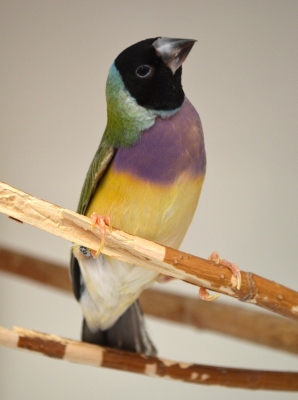
Our Animal of the Month for October was very much a kaleidoscope of colour. But now that the month is drawing to a close, we must say good-bye to the Gouldian finch. We hope you were following us all month long on Twitter @ExoticPetVets as we tweeted about these colourful characters. If you missed any of our tweets, here is a summary for your reference. Did you know?:
- There is some debate among experts over the scientific name for the Gouldian finch. Depending on the source, it is either Chloebia gouldiae or Erythrura gouldiae.
- There are some scientists who place Gouldian finches as the only species in the genus Chloebia because of the number of differences between Gouldian finches and other finches. Genus is the rank above species in taxonomy or biological classification.
- But there are other scientists who think that Gouldian finches should be in the genus Erythrura along with different species of parrot-finches.
- In terms of common name, the colourful Gouldian finch is sometimes referred to as the rainbow finch, Gould’s finch or the Lady Gouldian finch.
- The Gouldian finch is mostly associated with famed British ornithologist John Gould. But Gould actually named the Gouldian finch after his late wife Elizabeth to honour her substantial – and historically overlooked – contributions to his work.
- John Gould named the Gouldian finch in 1841 – the year his wife, Elizabeth Gould, died. Elizabeth Gould was a talented zoological artist and created many beautiful illustrations of bird specimens for her husband’s books.
- Gouldian finches are native to northern Australia. They are currently most numerous in the Northern Territory and Western Australia’s Kimberley region.
- While bred heavily in captivity, wild Gouldian finches are considered to be near-threatened by the IUCN Red List. There are estimates that fewer than about 2,500 adult Gouldian finches are in the wild.
- The wild Gouldian finch population was decimated by people trapping and exporting them for the pet industry. Australia outlawed the practice several decades ago.
- Illegal trapping, human agriculture and other habitat destruction are also harming the wild Gouldian finch population. And while snakes and hawks predate on Gouldian finches, feral cats are the most notable predators for these birds.
- Adult Gouldian finches typically grow to between 11 and 12.5 cms (4-5 inches) and they sport a lot of colour on their small bodies.
- Typically, Gouldian finches have a turquoise ring of feathers around their heads which give way to green all the way down their backs. They have purple breast feathers, yellow bellies and blue feathers on their rumps.
- Interestingly, Gouldian finches have three very distinct colour variations – they either have red heads, black heads or yellow heads. Initially it was thought that they were three different species, but they are all members of the same species.
- Researchers in the U.K. have found that the different head colours on Gouldian finches may hint at differing personality traits.
- Researchers studied red-headed and black-headed Gouldian finches, which are the two main colour morphs. Yellow-headed Gouldian finches are a more rare colour morph and were not studied.
- The researchers found that the red-headed Gouldian finches tended to be more aggressive, while the black-headed ones were more likely to take risks against predators.
- Researchers suggest this personality difference is linked to foraging behaviour in black-headed and red-headed Gouldian finches.
- Red stands out more in nature so black-headed Gouldian finches are less conspicuous than their red-headed counterparts; thus, researchers believe they are able to feed in riskier areas.
- Researchers suggest the red-headed Gouldian finches are more aggressive so they can secure safer foraging sites that protects them from predators.
- When it’s time to breed, male Gouldian finches will perform a fascinating courtship or mating dance for the female with whom he is interested in forming a pair bond.
- In his courtship dance, the male Gouldian finch will initially point his beak downward and shake his head rapidly before resuming an upright position and hopping up and down.
- If interested in mating, a female Gouldian finch will chirp at the male as he dances and point her tail toward him. She may also shake her head.
- Wild Gouldian finches build their nests in tree hollows. Females will lay a clutch of between 4-to-8 eggs.
- While female Gouldian finches will sit on the eggs at night, both the male and female will take turns sitting on the eggs during the day. It takes about two weeks for the eggs to hatch once they’re laid.
- Once the eggs have hatched, female and male Gouldian finches will share parenting duties equally. The chicks will start leaving the nest at around three weeks of age. When they are about 40 days old, they are fully independent.
- Gouldian finches in the wild will usually live about five years. But with proper care in captivity, they can reach eight years of age.

